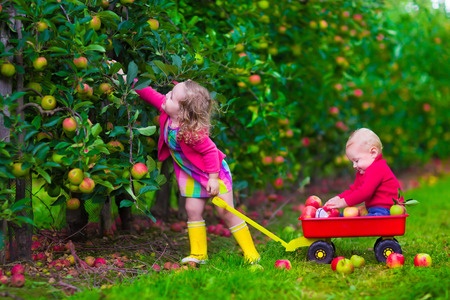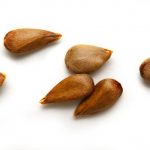
This year, the apple harvest, both for dessert and culinary purposes may be one of the earliest on record. It could be at least 4 to 6 weeks earlier than expected and is probably due to the harsh Winter experienced in the UK with benign conditions during the Spring for bud formation and of course a higher than average pollination. In our garden, cooking apples from the Bramley Seedling cultivar provide the main stay of stored fruit, used for puddings throughout a large part of the Winter. They are highly reliable and allow us a regular offering for crumbles and tarts, especially with the blackberries coming on song.
When I look for data on the flavour of apples in general, I always refer to reviews by Dimick and Hoskin (1983) and Paillard (1990) which gives a breakdown of all the componentry identified upto 1990. Generally, the esters contribute as in most fruit to aroma, but the degree of production depends on the availability and metabolism of a variety of C2 to C8 acids and their corresponding alcohols (Paillard 1979; De Pooter et al. 1981; Knee & Hatfield 1981). A number of factors naturally affect the flavour of apples, fruit maturity and ripeness is probably the most important, then the variety, growing conditions and culture techniques, and then physiology and post-harvest processing (Paillard, 1990; Brackmann et al., 1993).
Subsequent reviews assess the volatile changes during processing such as concentration (Dixon and Hewitt, 2000). Recent activity has focussed on the enzymic processes in the production of aromas in relation to ripening, and the role of ethylene (Schaffer et al., 2007). There is also a strong interest in the last 10 years on the underlying genetic elements which control flavour and aroma production in particular. Research on post-harvest technology at the University of California, Davis and by Plant & Food Research (ex. HortResearch) in New Zealand has been especially strong in this area. Numerous articles have now been published to understand the roles that biosynthetic enzymes play in the process (Janssen et al., 2008).
I’ve also been trying a few apple brandies and some calvados from suppliers in the West Country. Its great to sip a spirit which just gests increasingly warmer in the mouth and with a fully, rounded apple note. Having swallowed it, one is left with the warm glow in the throat until it is repeated with another gulp. The flavour and aroma of fermented apple products tends to dwell on ciders although there are a few references to apple wine and brandy (Schreier et al., 1978). One particular product I enjoyed at the Good Food Show-Summer (NEC, Birmingham) this year was the Number Nine™ apple brandy with blackcurrant from Celtic Marches Beverages Ltd. see web-site ( www.celticmarches.com). The addition of blackcurrant gave this liqueur a rich, acidic fruitiness with the characteristic catty note flavour that is so important.
I shall return with more posts on the subject of apples – this is really just a snapshot.
References
Brackmann, A., Streif, J., Bangerth, F. (1993) Relationship between a reduced aroma production and lipid metabolism of apples after long-term controlled atmosphere storage. J. Am. Soc. Hortic. Sci. 118,pp. 243-247.
Dimick, P., Hoskin, J. (1983) Review of apple flavorstate of the art. Crit. Rev. Food Sci. Nutr. 18, pp. 387–409.
De Pooter, H.L., Montens, J.P., Guido, A.W., Dirinck, P.J., Schamp, N.M.(1983) Treatment of Golden Delicious apples with aldehydes and carboxylic acids: effect on the headspace composition. J. Agric. Food Chem. 31 pp. 813–818.
Dixon, J., Hewett, E. W. (2000) Factors affecting apple aroma/flavour volatile concentration: A review. N. Z. J. Crop Hortic. Sci. 28, pp. 155-173.
Janssen, B., Thodey, K., Schaffer, R., Alba, R., Balakrishnan, L., Bishop, R., Bowen, J., Crowhurst, R., Gleave, A., Ledger, S., et al.: (2008) Global gene expression analysis of apple fruit development from the floral bud to ripe fruit. BMC Plant Biol., 8(16): DOI. 10.1186/1471-2229-1188-1116
Knee, M., Hatfield, S.G.S. (1981) The metabolism of alcohols by apple fruit tissue. J. Sci. Food Agric. 32: pp. 593–600
Paillard, N. M. M. (1979) Biosynthese des produits volatils de la pomme: Formation des alcools et des esters a partir des acides gras. Phytochemistry 18 pp. 1165- 1171.
Paillard, N. M. M. (1990) The flavour of apples, pears and quinces. In: Chapt. 1 Food flavours, Part C. The flavour of fruits. Morton, 1. D.; MacLeod, A. J. ed., Elsevier Science Publishing Company Inc. Amsterdam, The Netherlands Pp. 1-41.
Schaffer, R.J., Friel, E.N., Souleyre, E.J.F., Bolitho, K., Thodey, K., Ledger, S., Bowen, J.H., Ma, J.H., Nain, B, Cohen D, Gleave AP, Crowhurst RN, Janssen BJ, Yao J.L., Newcomb R.D. (2007) A Genomics Approach Reveals That Aroma Production in Apple Is Controlled by Ethylene Predominantly at the Final Step in Each Biosynthetic Pathway. Plant Physiol. 144(4) pp. 1899-1912.
Schreier, P., Drawert, F. and Schmid, M. (1978) Changes in the composition of neutral volatile components during the production of apple brandy. J. Sci. Food Agric., 29, pp. 728–736


Leave a Reply